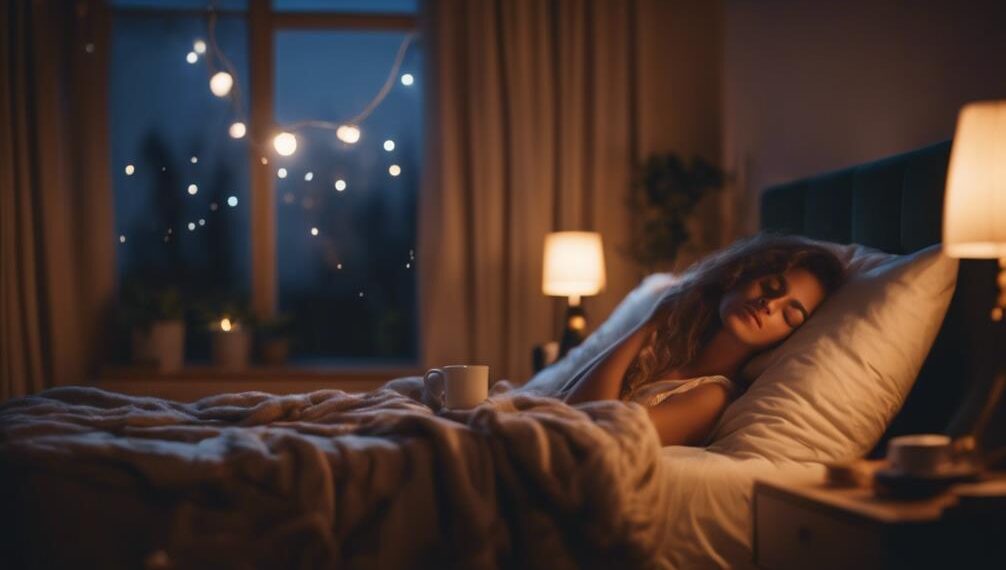Like a gentle lullaby soothing us into a restful slumber, circadian lighting plays a crucial role in improving our sleep quality.
The way light impacts our internal body clock is fascinating, but have you ever wondered why certain lighting can make a real difference in how well we sleep?
Let's explore the intricate connection between circadian lighting and our sleep patterns to unravel the science behind this phenomenon.
Key Takeaways
- Circadian lighting aligns with natural light changes to promote melatonin production.
- Exposure to artificial light suppresses melatonin, affecting sleep quality.
- Proper light cues from circadian lighting support a healthy sleep-wake cycle.
- Implementing circadian lighting benefits overall well-being by regulating sleep cycles.
Understanding Circadian Rhythm and Sleep
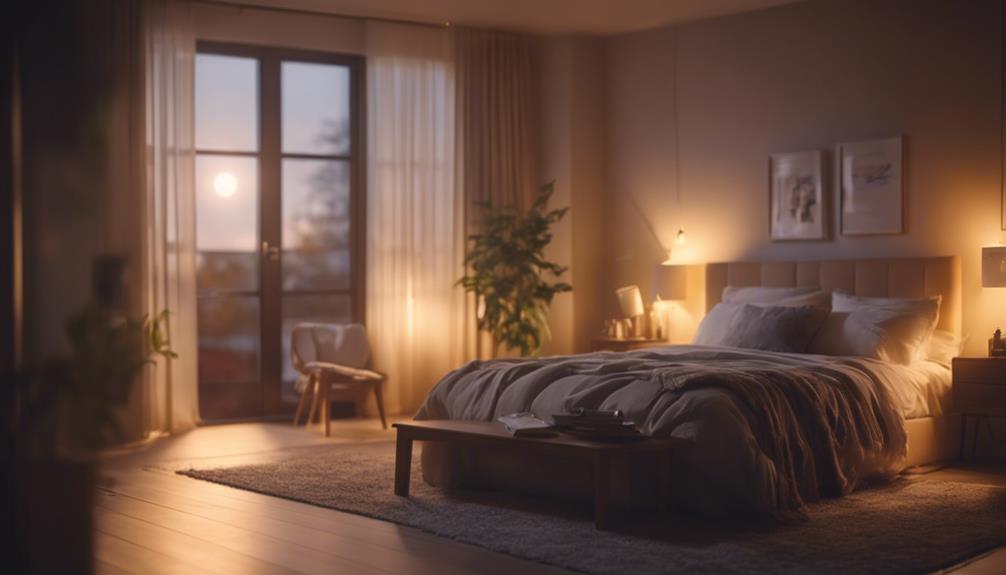
Understanding how our body's internal clock, known as the circadian rhythm, influences our sleep is essential for optimizing our restorative rest. The circadian rhythm regulates the timing of various physiological processes, including sleep-wake cycles, hormone release, and body temperature. Disruption of this rhythm can lead to sleep disorders such as insomnia, delayed sleep phase disorder, and shift work sleep disorder.
Our circadian rhythm is primarily influenced by external cues, with light being the most potent synchronizing agent. Light exposure, especially to blue light, plays a crucial role in regulating our internal clock. This is why exposure to bright light in the morning can help reset our circadian rhythm and improve sleep quality.
Research has shown that individuals with disrupted circadian rhythms are more prone to developing sleep disorders. By understanding the intricate relationship between our circadian rhythm and sleep, we can better manage our sleep patterns and address any underlying issues that may be affecting our rest.
Impact of Light on Sleep Quality
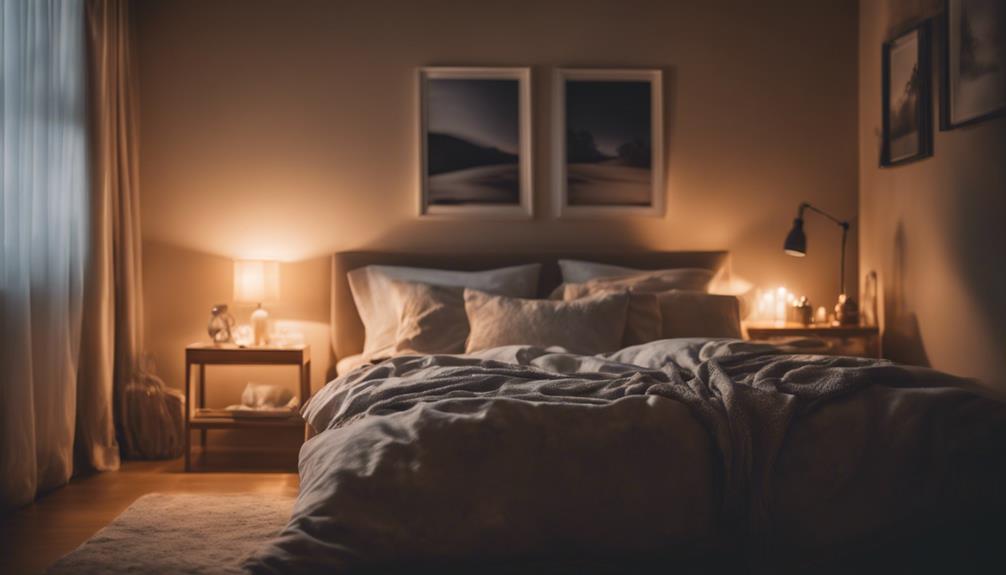
Light plays a crucial role in regulating our sleep-wake cycle by affecting the production of melatonin, the hormone that signals our bodies it's time to sleep.
Exposure to certain types of light, especially blue light emitted by screens, can disrupt our natural melatonin production and interfere with our ability to fall asleep.
Understanding the impact of light on our sleep quality is essential for maintaining a healthy circadian rhythm and promoting restful sleep.
Light and Melatonin
Exposure to different wavelengths of light during the evening hours significantly suppresses the production of melatonin, a hormone crucial for regulating the sleep-wake cycle. Melatonin is produced by the pineal gland in response to darkness, signaling to the body that it's time to sleep.
However, exposure to artificial light, especially blue light emitted by screens and LED lights, inhibits melatonin production, leading to difficulty falling asleep. Research indicates that this disruption of melatonin regulation can result in poor sleep quality and disturbances in the circadian rhythm.
To mitigate this effect, it's recommended to limit exposure to bright light sources in the evening and incorporate circadian lighting solutions that mimic the natural progression of light throughout the day, supporting melatonin production and promoting better sleep.
Sleep-Wake Cycle
The synchronization of our internal body clock with external light cues significantly influences the quality of our sleep. Our sleep patterns are intricately linked to the regulation of our biological clock, also known as the circadian rhythm. Disruptions to this rhythm, often caused by improper exposure to light, can lead to difficulties falling asleep, staying asleep, and achieving restorative sleep stages. Research shows that exposure to artificial light, especially blue light emitted by electronic devices, can suppress the production of melatonin, a hormone that helps regulate sleep-wake cycles. Implementing circadian lighting that mimics the natural changes in light throughout the day can help realign our internal clock, improve sleep quality, and promote overall well-being.
| Disruptions to Sleep Patterns | Impact on Biological Clock |
|---|---|
| Difficulty falling asleep | Altered circadian rhythm |
| Fragmented sleep stages | Reduced melatonin levels |
Benefits of Circadian Lighting

Circadian lighting offers a range of benefits, including the regulation of our sleep cycles, which can lead to improved sleep quality.
This type of lighting has been shown to positively impact mood and energy levels, promoting alertness during the day and better relaxation at night.
Additionally, the use of circadian lighting has been linked to overall health and well-being, making it a valuable asset in optimizing our daily routines.
Sleep Cycle Regulation
Regulating our sleep cycles through the strategic implementation of appropriate lighting can significantly enhance our overall sleep quality and well-being. Sleep patterns are intricately tied to our circadian rhythm, the internal clock that regulates our sleep-wake cycle.
Disruptions in this cycle can lead to poor sleep quality, impacting our alertness and overall health. Lighting effects play a crucial role in maintaining a healthy circadian rhythm. Bright light exposure during the day helps synchronize our internal clock, promoting wakefulness, while dimmer, warmer lighting in the evening signals the body to prepare for sleep.
Mood and Energy
Enhancing mood and energy levels can be achieved through the strategic utilization of circadian lighting, which optimizes the synchronization of our internal clock for improved well-being.
Research indicates that exposure to light, especially blue-enriched light, during the day enhances alertness and elevates mood by suppressing the production of melatonin, the hormone that induces sleep.
By simulating natural light patterns, circadian lighting helps regulate our sleep-wake cycles, leading to increased energy levels during the day. This regulation not only boosts alertness but also contributes to emotional balance by influencing neurotransmitters like serotonin and dopamine.
As a result, individuals experience improved moods, increased productivity, and a greater sense of well-being when circadian lighting is integrated into their daily environments.
Health and Well-being
Research studies have demonstrated that the implementation of circadian lighting systems positively impacts overall health and well-being by influencing various physiological processes. Circadian lighting can aid in stress management by regulating the production of cortisol, the stress hormone, helping individuals maintain a balanced response to stressors. Moreover, it can influence nutrition choices by affecting appetite-regulating hormones like leptin and ghrelin, potentially leading to healthier eating habits. The table below summarizes key benefits of circadian lighting on health and well-being:
| Benefits of Circadian Lighting |
|---|
| Regulates cortisol levels for stress management |
| Influences appetite-regulating hormones for better nutrition choices |
| Supports overall health and well-being by aligning with the body's natural rhythms |
Science Behind Improved Sleep Patterns
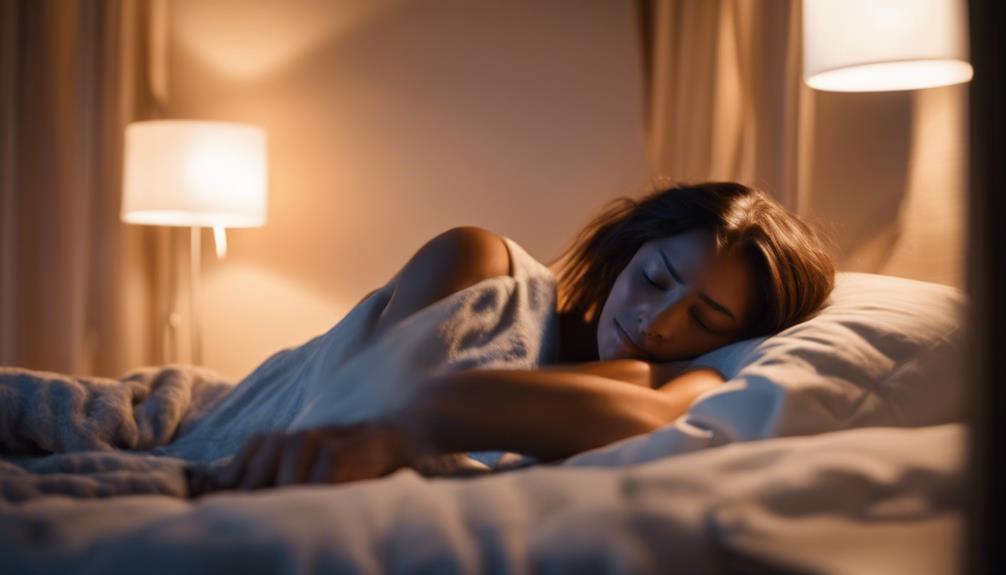
Understanding the mechanisms by which circadian lighting influences sleep patterns requires a deep dive into the intricate interplay between light exposure and our internal biological clock. Circadian lighting impacts our sleep patterns through various pathways:
- Regulation of Melatonin: Circadian lighting affects the production of melatonin, a hormone that regulates sleep-wake cycles. Bright light exposure suppresses melatonin production, signaling wakefulness.
- Synchronization of Circadian Rhythms: Light exposure helps synchronize our internal biological clock with the external environment, ensuring that our sleep-wake cycles align with the natural day-night cycle.
- Impact on Sleep Disorders: Circadian lighting interventions have shown promise in managing sleep disorders such as insomnia and circadian rhythm disorders by optimizing light exposure to promote better sleep quality.
Research indicates that circadian lighting plays a crucial role in modulating our sleep patterns by influencing hormone production and aligning our internal clock with external cues. By understanding these underlying mechanisms, we can harness the power of light to improve our sleep quality naturally and effectively.
Implementing Circadian Lighting Solutions
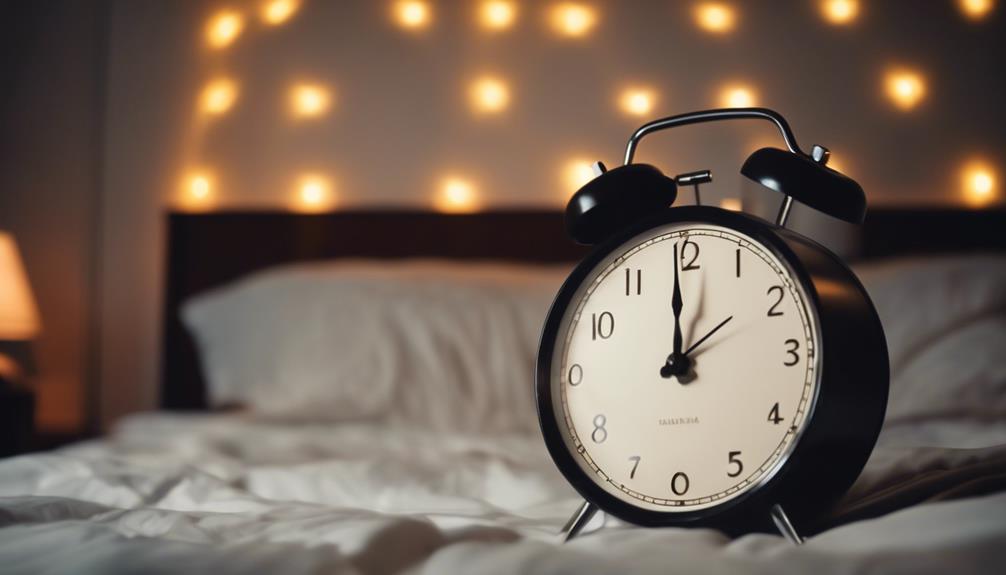
To effectively apply circadian lighting solutions, it is essential to consider the specific lighting needs and preferences of individuals based on their daily routines and environmental factors. Lighting design plays a crucial role in creating an environment that supports our natural sleep-wake cycle. By incorporating sleep technology into lighting systems, such as adjustable color temperatures and brightness levels, we can mimic the natural changes in light throughout the day to enhance our circadian rhythms.
| Light Intensity | Color Temperature | Time of Day | Mood |
|---|---|---|---|
| High | 6500K | Morning | Alertness |
| Medium | 5000K | Afternoon | Productivity |
| Low | 3000K | Evening | Relaxation |
| Very Low | 2700K | Night | Sleepiness |
Understanding the impact of different lighting conditions on our bodies can help tailor lighting solutions to meet individual needs. By optimizing lighting design with the latest sleep technology, we can create spaces that promote better sleep quality and overall well-being.
Tips for Optimizing Sleep Environment
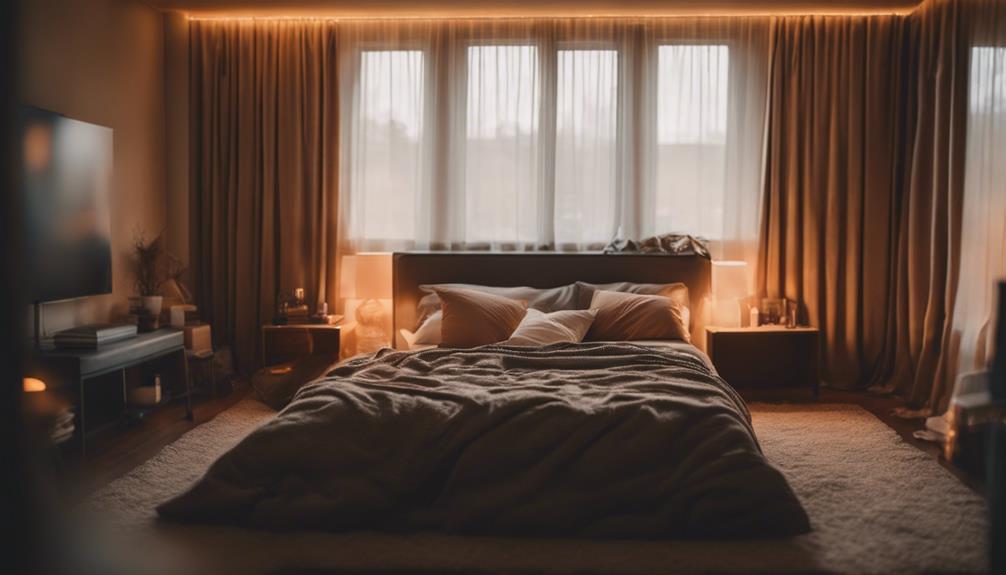
In optimizing the sleep environment, it's crucial to carefully control lighting conditions to align with our natural circadian rhythms. The sleep environment plays a significant role in promoting restful sleep, and certain design elements can enhance this experience. Here are three essential tips for optimizing your sleep environment:
- Consider Lighting Placement: Position light sources strategically to mimic natural light patterns. Exposure to bright light during the day and dimmer light in the evening can help regulate your internal body clock and improve sleep quality.
- Choose Soothing Color Schemes: Opt for cool hues like blues and greens for a calming effect in the bedroom. Avoid bright, stimulating colors that can disrupt relaxation and hinder the transition to sleep.
- Control Light Intensity: Install dimmer switches or use adjustable lighting fixtures to customize the light levels according to your needs. Dimming the lights closer to bedtime signals to your body that it's time to wind down and prepare for sleep.
Frequently Asked Questions
Can Circadian Lighting Be Harmful to Our Eyes or Overall Health in Any Way?
Yes, circadian lighting can have potential risks to our eyes and overall health. Prolonged exposure may lead to eye strain and disrupt our natural sleep-wake cycles, impacting our health.
Research suggests that excessive exposure to certain types of circadian lighting can have negative health effects, such as disrupting melatonin production.
It's essential to strike a balance and use circadian lighting responsibly to mitigate these risks and promote overall well-being.
How Does Circadian Lighting Compare to Other Sleep Aids, Such as Melatonin Supplements or White Noise Machines?
When comparing circadian lighting to other sleep aids like melatonin supplements or white noise machines, we find that each has its own effectiveness. Circadian lighting influences our sleep patterns by mimicking natural light changes, while melatonin can directly affect our sleep hormones, and white noise machines mask disruptive sounds.
Cost analysis reveals that circadian lighting may require a higher initial investment but can offer long-term benefits, making it a viable option for improving sleep quality.
Are There Specific Populations, Such as Children or Elderly Individuals, Who May Benefit More From Circadian Lighting for Improving Sleep Quality?
Children and elderly individuals show significant benefits in sleep quality when exposed to circadian lighting. Studies indicate that children with proper circadian lighting have improved sleep patterns and better cognitive performance.
Likewise, the elderly benefit from enhanced sleep quality and mood regulation. These populations, with their unique sleep needs, stand to gain the most from the tailored effects of circadian lighting on their circadian rhythms.
Can Circadian Lighting Be Used in Combination With Other Sleep Hygiene Practices, Such as Maintaining a Consistent Bedtime Routine or Reducing Screen Time Before Bed?
Combining circadian lighting with bedtime routine can enhance sleep quality by regulating our body's internal clock.
Dimming lights in the evening signals the brain to produce melatonin, aiding in falling asleep.
Limiting screen time before bed is crucial as electronic devices emit blue light, disrupting our sleep-wake cycle.
Maintaining a consistent bedtime routine and using circadian lighting work synergistically to promote better sleep patterns and overall well-being.
Are There Any Potential Drawbacks or Limitations to Using Circadian Lighting for Improving Sleep Quality That Individuals Should Be Aware Of?
When considering circadian lighting for sleep, users should be mindful of potential drawbacks and limitations. Cost and maintenance are key factors to consider. Regular maintenance is crucial to ensure optimal functionality.
Additionally, the initial cost of installing circadian lighting systems can be a barrier for some individuals. Despite these challenges, the benefits of improved sleep quality may outweigh the drawbacks for many users.
How Does Circadian Lighting Impact Sleep Quality?
Circadian lighting can significantly affect sleep quality. Exposure to natural light during the day and dim, warm lighting in the evening can help regulate the sleep-wake cycle. Following these tips for better sleep can improve overall sleep quality and promote a healthier circadian rhythm.
Conclusion
In conclusion, it's clear that circadian lighting plays a crucial role in improving sleep quality by aligning our internal body clock with external light cues. The science behind this phenomenon is well-documented, showing the significant impact light has on our sleep patterns.
By implementing circadian lighting solutions and optimizing our sleep environment, we can achieve better sleep outcomes. It's ironic that something as simple as light can have such a profound effect on our rest, but the evidence speaks for itself.

